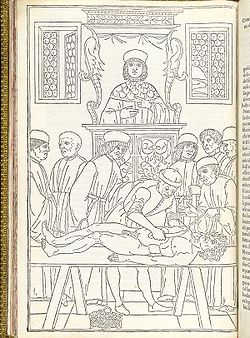
Fasciculus medicinae
Encyclopedia

Uroscopy
Uroscopy is the historic medical practice of visually examining a patient's urine for pus, blood, or other symptoms of disease. It dates back to ancient Egypt, Babylon, and India. It was particularly emphasized in Byzantine medicine....
, astrology
Astrology
Astrology consists of a number of belief systems which hold that there is a relationship between astronomical phenomena and events in the human world...
, bloodletting
Bloodletting
Bloodletting is the withdrawal of often little quantities of blood from a patient to cure or prevent illness and disease. Bloodletting was based on an ancient system of medicine in which blood and other bodily fluid were considered to be "humors" the proper balance of which maintained health...
, the treatment of wounds, plague
Bubonic plague
Plague is a deadly infectious disease that is caused by the enterobacteria Yersinia pestis, named after the French-Swiss bacteriologist Alexandre Yersin. Primarily carried by rodents and spread to humans via fleas, the disease is notorious throughout history, due to the unrivaled scale of death...
, anatomical dissection
Dissection
Dissection is usually the process of disassembling and observing something to determine its internal structure and as an aid to discerning the functions and relationships of its components....
, and women’s health. The book is remarkable as the first illustrated medical work to appear in print; notable illustrations include: a urine
Urine
Urine is a typically sterile liquid by-product of the body that is secreted by the kidneys through a process called urination and excreted through the urethra. Cellular metabolism generates numerous by-products, many rich in nitrogen, that require elimination from the bloodstream...
chart, a diagram of the vein
Vein
In the circulatory system, veins are blood vessels that carry blood towards the heart. Most veins carry deoxygenated blood from the tissues back to the heart; exceptions are the pulmonary and umbilical veins, both of which carry oxygenated blood to the heart...
s for phlebotomy
Phlebotomy
Phlebotomy is the process of making an incision in a vein.It is associated with the following concepts:* Venipuncture, the practice of collecting venous blood samples* The main practice of a phlebotomist, an individual trained to draw blood...
, a pregnant woman, Wound Man
Wound Man
Wound Man is an illustration which first appeared in European surgical texts in the Middle Ages. It laid out schematically the various wounds a person might suffer in battle or in accidents, often with surrounding or accompanying text stating treatments for the various injuries...
, Disease Man and Zodiac Man. In 1495, it appeared in Italian under the title Fasiculo de Medicina.
The ten handsome full-page woodcut
Woodcut
Woodcut—occasionally known as xylography—is a relief printing artistic technique in printmaking in which an image is carved into the surface of a block of wood, with the printing parts remaining level with the surface while the non-printing parts are removed, typically with gouges...
illustrations influenced artists for some time - even as late as 1751 when the last of William Hogarth
William Hogarth
William Hogarth was an English painter, printmaker, pictorial satirist, social critic and editorial cartoonist who has been credited with pioneering western sequential art. His work ranged from realistic portraiture to comic strip-like series of pictures called "modern moral subjects"...
's Four Stages of Cruelty seems to borrow from the dissection scene (above).
External links
- Johannes de Ketham: Fasiculo de medicina (Venice, 1495). Selected pages scanned from the original work. Historical Anatomies on the Web. US National Library of Medicine.
- Turn the pages of a virtual copy of Fasiculo de Medicina at the National Library of Medicine's website Click your mouse on the right side of the book cover to start.

